Mukunda
By Gorilla Doctors Staff on Wednesday, July 28th, 2010 in Uncategorized.Mukunda is the 15-year-old son of Senkwekwe. He is a sliverback who saw his father, mother and five other family members shot and killed in Congo in 2007. At the time he was a blackback gorilla who helped the remaining family to flee the horror of that day. He has been living in Rugendo group, a small remnant of the original family with only one adult female. At 15 years of age, and a young silverback, he was ready to find a family of his own, and started leaving the group for long periods of time. He has recently become a lone silverback, and is roaming the forest and outside the forest, covering many kilometers each day.
Last month I received a call from Emmanuel, the Chief Park Warden for PNVi in Congo. Mukunda was 10 km outside the park, 300 meters from the main road to Rumangabo. He had been outside the park for almost 2 weeks and was destroying crops. The people who lived in that area were very mad, and understandably so – this was a dangerous situation for Mukunda, and for the local villagers. He needed to be moved back to the forest, and the only way to do that was to anesthetize him and carry him back, well inside the forest.
Mukunda very near a house in the village.This was a huge responsibility. We had to keep this silverback gorilla anesthetized for at least 5 hours while he was carried over steep hills, through villages and then via truck to the forest edge where he had to be carried as deep into the forest as we could get. The procedure was not without risk, but after long discussions with Emmanuel, Dr. Eddy and Dr.Jacques, we realized that the potential risks were well outweighed by the benefits of moving him. If we did not move Mukunda he could be killed. We immediately put together a plan to go to him the next day. As we gathered our veterinary team, Innocent, the ICCN (the wildlife authority in Congo) ranger in charge of that area, gathered a great team of experienced rangers and volunteers to carry Mukunda. He also had a large wooden platform with handles built to hold Mukunda’s weight, and purchased mattresses so that this heavy animal was not bruised on the trip.
The morning of the intervention Dr. Eddy, Dr. Arthur and I started very early from Goma and drove to the spot where Mukunda was last seen. We came to a spot where we could see hundreds of people in the fields, following Mukunda. It took us about 30 minutes to walk to where he was from the road, and all along the way more and more people appeared. NOT the best environment for a dicey gorilla anesthesia…
Dr. Eddy darted him very successfully in the banana field, while surrounded by villagers. The volunteers and rangers tried to keep people back, but it isn’t every day there is a 350 lb gorilla in your back yard… We could see the path of destruction Mukunda had left – banana trees were down, bean fields looked plowed, and throngs of people covered the fields. Dr. Eddy, Dr. Arthur and I quickly collected our samples, and Mukunda was hoisted onto a wooden platform with handles. At least 350 lbs. We had 10 men on each side of the platform laboring through the village, walking for over an hour to the road where the truck was waiting. It was a hot, sunny day, with no breeze at all, we had a whole village following us, and the noise was crazy.
Monitoring anesthesia under these conditions was difficult – and the people carrying him were working hard. We put him down each 10 minutes to take a pulse, respiratory rate and temperature. Each time the platform went up or down there were groans as these strong men struggled not to drop him. They encouraged each other, and there were shouts of “polepole!!!”, which means “slowly slowly!” in Swahili. It was a long walk for everyone. Once we got him into the truck Dr. Eddy and I stayed with Mukunda so that we could monitor him, and administer more drugs when necessary. It was a bit surreal, but Mukunda did well. Then another hour to get him back to the forest. We dealt with a slight bloat of his stomach from the drugs we administered, and his body temperature rose precariously – but stabilized once we covered him in a wet sheet. We were also very concerned about all of the human contact. There was so much potential for disease transmission. Fortunately, when we got back to the lab the next day and analyzed Mukunda’s blood we found no abnormalities.
Mukunda being carried.
Dr. Eddy and Mukunda in the truck
We finally found a good spot in the shade to administer the reversal drugs, and Mukunda slowly woke up. As he regained his strength he looked through the small gathering of rangers and veterinarians, his eyes stopped on Dr. Eddy, as if he remembered him – maybe from the darting! It was time for us to go back to the lab and sort through our samples and restock the darting kit. Innocent had a ranger stay with Mukunda the rest of the day.
Mukunda waking from anesthesia
We learned that Mukunda was back to himself the next day, and he did stay in the park for several days, but unfortunately he decided to raid crops again and was chased back into the park by rangers. Several days later there was a Mukunda sighting in Rwanda – he had crossed the border and was coming outside the park in Rwanda now! Poor guy – we were really fearing for his life at this point. There were many discussions with the wildlife authorities of both countries, brainstorming about how to keep this magnificent young silverback in the park. This wandering outside the park was not his fault – he was habituated as a very young animal to accept human presence, and his habitat has been reduced by human encroachment. But people and gorillas MUST live together in harmony if gorilla conservation is to work.
We talked of erecting an electric fence – this has worked for wayward elephants in other parts of the park. We talked of airlifting him to a remote location much like we do bears in the US, but the habitat is not large enough for Mukunda – he walks kilometers every day. We talked of extremely negative reinforcement if he leaves the park, but this could be dangerous. In the meantime Mukunda decided he liked it better in his home country and crossed back to DRC, and seemed to be staying inside the park. We all breathed a bit of a sigh of relief, but it was short lived.
Mukunda raided the market at Kibumba, a village in DRC on the road to Rumangabo. This was a terrible and very dangerous situation. People were very angry – Mukunda was destroying crops and structures. We had to move him again or he would surely be killed. This time, as we drove on the main road to Rumangabo, there was no mistaking Mukunda’s position. Hundreds, if not over a thousand people were gathered, and Mukunda was nearly on the road. As we prepared our dart people chased him into the village. Have a look at the photos below which illustrate this difficult event.
 Preparing the dart with many onlookers; Dr.Mike, Dr. Jan, Dr. Eddy and Dr. Noel.
Preparing the dart with many onlookers; Dr.Mike, Dr. Jan, Dr. Eddy and Dr. Noel.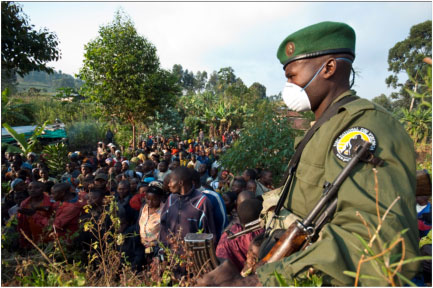 Trying to keep curious people away for safety reasons
Trying to keep curious people away for safety reasons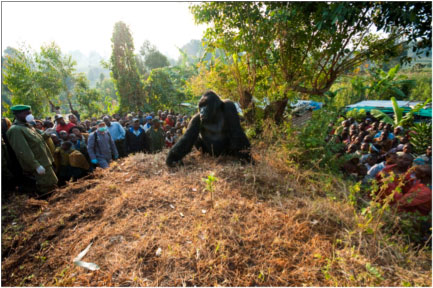 After Dr. Eddy darted him he went to the top of this small hill and quietly went to sleep
After Dr. Eddy darted him he went to the top of this small hill and quietly went to sleep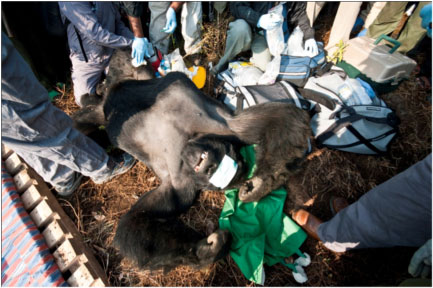 As always, we took as many samples of blood, skin, feces, and urine as we could to learn as much as we could from this opportunity.
As always, we took as many samples of blood, skin, feces, and urine as we could to learn as much as we could from this opportunity.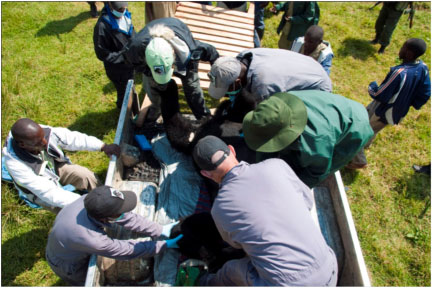 We loaded him onto the truck and took him back to the forest once again.
We loaded him onto the truck and took him back to the forest once again.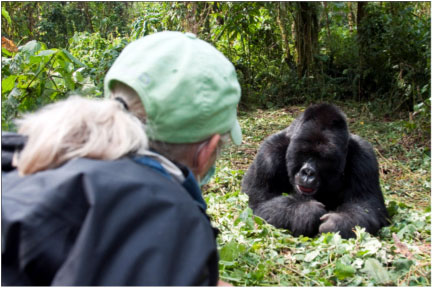 We watched him closely until he was awake, then returned home to plan how to keep him safe in the forest.For the past week Mukunda has stayed in the forest, but we know it is only a matter of time before he gets himself into trouble again with people. ICCN is building an electric fence to cover the whole sector that Mukunda ranges – a HUGE job, but this speaks to the dedication of ICCN to save these animals and protect the people who live near them. Let’s hope and pray this works so that Mukunda can live out his life in the forest as a happy, healthy Mountain Gorilla.
We watched him closely until he was awake, then returned home to plan how to keep him safe in the forest.For the past week Mukunda has stayed in the forest, but we know it is only a matter of time before he gets himself into trouble again with people. ICCN is building an electric fence to cover the whole sector that Mukunda ranges – a HUGE job, but this speaks to the dedication of ICCN to save these animals and protect the people who live near them. Let’s hope and pray this works so that Mukunda can live out his life in the forest as a happy, healthy Mountain Gorilla.
Here is a video of the final intervention:


 Donate
Donate